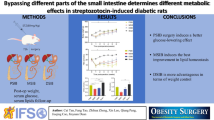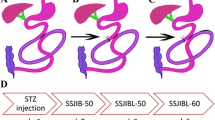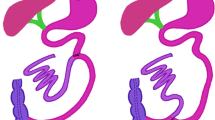Abstract
Background
Jejunoileal bypass (JIB) can markedly ameliorate diabetes in obese patients and rodents. The aim of this study is to systematically evaluate the role of the operational manner and the retained distal small bowel length in mediating changes in glucose homeostasis after intestinal bypass surgeries in nonobese diabetic rats.
Methods
Streptozotocin-induced diabetic rats underwent side-to-side jejunoileal bypass plus proximal loop ligation (SSJIBL), end-to-side jejunoileal bypass (ESJIB), proximal small bowel resection (PBR), and sham operation. Each operational manner included two subgroups, in which 30 cm (L-30) or 40 cm (L-40) distal small bowel was retained. Main outcome measures were fasting blood glucose levels (FBG), insulin sensitivity, serum insulin, glucagon-like peptide-1 (GLP-1), bilirubin (BIL), and total bile acids (TBA) levels.
Results
Global food intake in the sham group was higher than in the operation groups, and global body weight and food intake in the SSJIBL group were higher than in the ESJIB and PBR groups. Global body weight and food intake in L-40 group were higher than in L-30 group. The SSJIBL procedure induced better improvement in glucose homeostasis and insulin sensitivity than the ESJIB and PBR procedures, and L-30 group showed better antidiabetic effects than L-40 group. Serum GLP-1, BIL, and TBA levels in SSJIBL group were higher than in ESJIB and PBR groups.
Conclusions
This study shows that side-to-side jejunoileal bypass induced better glucose-lowering effects than end-to-side jejunoileal bypass and proximal small bowel resection, and intestinal bypass surgery that retained shorter distal small bowel yielded better antidiabetic effects.





Similar content being viewed by others
References
Lutrzykowski M. Vertical gastric resection (sleeve gastrectomy) in a morbidly obese patient with past jejunoileal bypass. Obes Surg. 2007;17(3):423–5.
Botsford TW, Gazzaniga AB. Blind pouch syndrome. A complication of side to side intestinal anastomosis. Am J Surg. 1967;113(4):486–90.
Kim J-P, Kwon O, Oh ST, et al. Results of surgery on 6589 gastric cancer patients and immunochemosurgery as the best treatment of advanced gastric cancer. Ann Surg. 1992;216(3):269–78.
Klaus A, Hinder RA, Nguyen JH, et al. Small bowel transit and gastric emptying after biliodigestive anastomosis using the uncut jejunal loop. Am J Surg. 2003;186(6):747–51.
Duan J, Yuan L, Zhou J. Side-to-side jejunoileal anastomosis plus proximal loop ligation: a novel intestinal bypass model for diabetic rats. Obes Surg. 2014;24(1):141–2.
Crespo MJ, Cruz N, Quidgley J, et al. Daily administration of atorvastatin and simvastatin for one week improves cardiac function in type 1 diabetic rats. Pharmacology. 2014;93(1–2):84–91.
Breen DM, Rasmussen BA, Kokorovic A, et al. Jejunal nutrient sensing is required for duodenal-jejunal bypass surgery to rapidly lower glucose concentrations in uncontrolled diabetes. Nat Med. 2012;18(6):950–5.
Klaus A, Weiss H, Kreczy A, et al. A new biliodigestive anastomosis technique to prevent reflux and stasis. Am J Surg. 2001;182(1):52–7.
Qin J, Li Y, Cai Z, et al. A metagenome-wide association study of gut microbiota in type 2 diabetes. Nature. 2012;490(7418):55–60.
Viddal KO. Intestinal bypass. A randomized, prospective clinical study of end-to-side and end-to-end jejunoileal bypass. Scand J Gastroenterol. 1983;18(5):627–34.
Williamson RC, Bauer FL, Ross JS, et al. Proximal enterectomy stimulates distal hyperplasia more than bypass or pancreaticobiliary diversion. Gastroenterology. 1978;74(1):16–23.
Johansen NJ, Frugier T, Hunne B, et al. Increased peripherin in sympathetic axons innervating plantar metatarsal arteries in STZ-induced type I diabetic rats. Front Neurosci. 2014;8:99.
Fuertes-Zamorano N, Sanchez-Pernaute A, Torres Garcia AJ, et al. Bariatric surgery in type 1 diabetes mellitus; long-term experience in two cases. Nutr Hosp. 2013;28(4):1333–6.
Raab H, Weiner RA, Frenken M, et al. Obesity and metabolic surgery in type 1 diabetes mellitus. Nutr Hosp. 2013;28 Suppl 2:31–4.
Middelbeek RJ, James-Todd T, Patti ME, et al. Short-term insulin requirements following gastric bypass surgery in severely obese women with type 1 diabetes. Obes Surg. 2014.
Blanco J, Jimenez A, Casamitjana R, et al. Relevance of beta-cell function for improved glycemic control after gastric bypass surgery. Surg Obes Relat Dis. 2014;10(1):9–13.
Dirksen C, Jacobsen SH, Bojsen-Moller KN, et al. Reduction in cardiovascular risk factors and insulin dose, but no beta-cell regeneration 1 year after Roux-en-Y gastric bypass in an obese patient with type 1 diabetes: a case report. Obes Res Clin Pract. 2013;7(4):e269–74.
Gonzalez E, Rosello-Catafau J, Jawerbaum A, et al. Pancreatic nitric oxide and oxygen free radicals in the early stages of streptozotocin-induced diabetes mellitus in the rat. Braz J Med Biol Res. 2000;33(11):1335–42.
Kohli R, Setchell KD, Kirby M, et al. A surgical model in male obese rats uncovers protective effects of bile acids post-bariatric surgery. Endocrinology. 2013;154(7):2341–51.
Simonen M, Dali-Youcef N, Kaminska D, et al. Conjugated bile acids associate with altered rates of glucose and lipid oxidation after Roux-en-Y gastric bypass. Obes Surg. 2012;22(9):1473–80.
Werling M, Vincent RP, Cross GF, et al. Enhanced fasting and post-prandial plasma bile acid responses after Roux-en-Y gastric bypass surgery. Scand J Gastroenterol. 2013;48(11):1257–64.
Duan J, Zhou J, Ren F, et al. Mid to distal small bowel resection with the preservation of the terminal ileum improves glucose homeostasis in diabetic rats by activating the hindgut-dependent mechanism. J Gastrointest Surg. 2014: 1–8.
Kohli R, Kirby M, Setchell KD, et al. Intestinal adaptation after ileal interposition surgery increases bile acid recycling and protects against obesity-related comorbidities. Am J Physiol Gastrointest Liver Physiol. 2010;299(3):G652–60.
Stocker R, Yamamoto Y, McDonagh AF, et al. Bilirubin is an antioxidant of possible physiological importance. Science. 1987;235(4792):1043–6.
Dong H, Huang H, Yun X. Bilirubin increases insulin sensitivity in leptin-receptor deficient and diet-induced obese mice through suppression of ER stress and chronic inflammation. Endocrinology. 2014;155(3):818–28.
Conflict of Interest
All authors declare to have no conflict of interest.
Statement of Informed Consent
Informed consent does not apply to the study.
Statement of Animal Rights
All applicable institutional and/or national guidelines for the care and use of animals were followed. The experiments were carried out in accordance with and were approved by the Ethical Committee on Animal Experimentation of Xiangya Medical College, Central South University of Science and Technology, China (Permit number: S249).
Author information
Authors and Affiliations
Corresponding author
Rights and permissions
About this article
Cite this article
Duan, J., Tan, C., Xu, H. et al. Side-to-Side Jejunoileal Bypass Induces Better Glucose-Lowering Effect than End-to-Side Jejunoileal Bypass on Nonobese Diabetic Rats. OBES SURG 25, 1458–1467 (2015). https://doi.org/10.1007/s11695-014-1549-7
Published:
Issue Date:
DOI: https://doi.org/10.1007/s11695-014-1549-7




